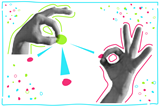Combine these two tools for best effect

A recent study suggests combining concept maps (CMs) and creative exercises (CEs) helps students to understand chemistry conceptually.
CMs enable students to visually organise concepts and identify connections between them, using linking phrases to explain relationships. These maps force students to show how different concepts fit into their knowledge framework. This process helps them to relate new material to what they already know. In turn, this supports meaningful learning rather than rote learning.
CEs are a related technique. A CE is an open-ended activity – students are given a prompt and are asked to write as many accurate, distinct and relevant statements as they can. The process requires them to link related concepts to each other.
CEs and CMs develop learners’ abilities to make connections between different concepts. This is an essential skill for a chemist to develop in order to apply knowledge in solving complex problems.
Additive powers
In their study, Li Ye and colleagues investigated the effect of combining CMs and CEs. A student cohort was taught together in lectures, but was broken into four smaller groups of 55–60 students for recitation sessions led by teaching assistants. The session activities were based on equilibrium and acid–base chemistry. The study compared a group of students who used both CMs and CEs in their recitation sessions with two groups of students who only used one of the two approaches and another group who used neither approach.
The researchers used pre- and post-testing to judge students’ performance. The tests used pre-existing concept inventories. The team then investigated differences in verbal explanations between the groups using focus group interviews. Finally, an open-ended survey collected students’ perceptions of the activities.
Making connections
Students found the activities helped them to think about their own learning (metacognition) and forced them to recall and link basic concepts to more advanced ones. One student noted that CEs ensure you know what you are learning since it isn’t possible to memorise and copy statements from notes when responding to a CE prompt. The survey data indicated that the combination of CMs with CEs helped students to understand chemistry conceptually, and helped them to make connections between concepts.
Interestingly, none of the experimental groups showed improved performance on the post-test assessment. However, the focus group responses from students who completed CM and CE activities indicated they were able to give more scientific explanations. The fact that the study revealed no significant improvement in students‘ post-test scores should not deter teachers from exploring the approach. CMs and CEs are two distinct techniques for encouraging students to develop a synoptic view of chemistry and are a valuable addition to any teacher’s toolkit.
Teaching tips
- My own introduction to CMs came in my training year when I used an excellent RSC resource for revising acids.
- If you are unfamiliar with CEs, the examples in the supplementary information of the study are a useful guide. The examples map well onto A-level and Advanced Highers content. These activities are not resource-intensive – the main input is the intellectual effort of the students.
- Introduce CMs before CEs. The findings of this study indicate that prior completion of a CM assisted students in completing a CE, since the former encourages them to identify the related concepts within a topic. This then helps them to write responses to a CE prompt more confidently.
- Get students to generate personalised CMs with the assistance of word banks and technology tools that incorporate equations and symbols. Students in the study preferred these CMs.
- Allow students to collaborate on CEs. This seems to benefit students and prompts feedback from teachers.
- Ensure that students understand the rationale for the exercises. Given the importance of exam performance, particularly for those seeking the highest grades, CEs might be useful in combination with tricky exam questions that tests students’ abilities to draw on knowledge across a range of concepts.
- Use CEs as an opportunity for peer assessment. The development of rubrics to assist in grading responses based on level of sophistication could help students improve their own responses.
References
L Ye et al., Chem. Educ. Res. Pract., 2020, 21, 1000 (DOI: 10.1039/d0rp00038h)














No comments yet